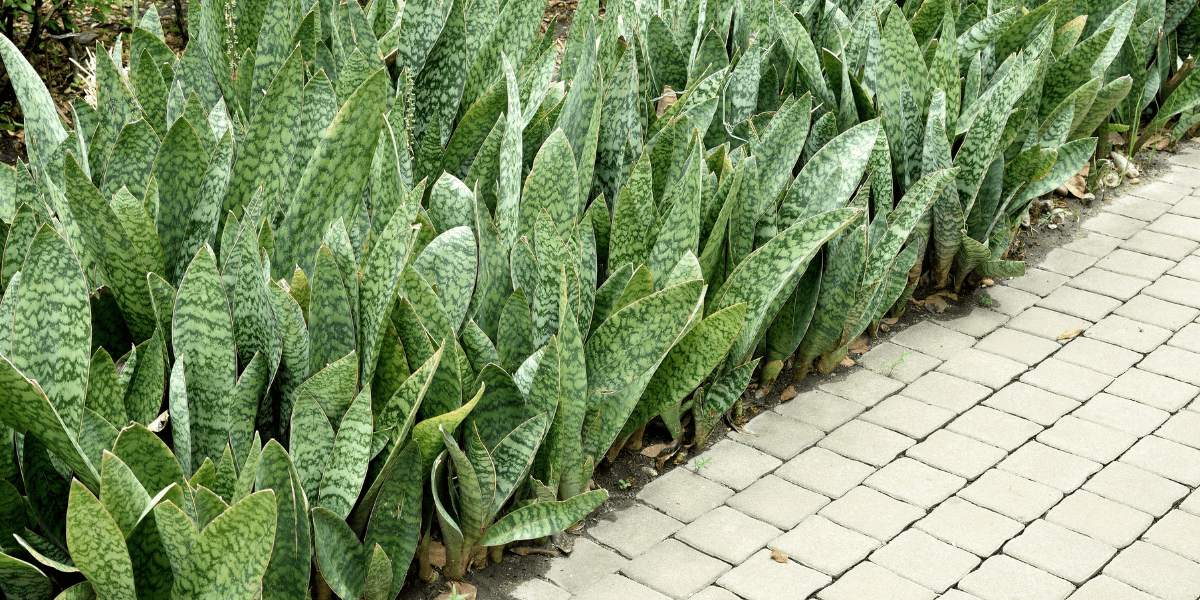Have you noticed brown spots on the leaves of your houseplants…
… or any unsightly brown areas in the foliage?
If so, you may be wondering what the problem is…
There are a number of reasons why houseplant leaves appear brown…
… but most of them can be prevented and even addressed.
Hear it from Tana!
I’ve never been a serious gardener in my whole life.
But having houseplants at home is something I need…
...since houseplants have helped me by providing greeneries…
… at home, in the middle of city life.
Houseplants have also done a lot to help me relax when I get home from work.
As a result, the two conditions just don’t add up for me.
Especially this one time when I noticed brown spots on most of my houseplant’s leaves.
My first thought was that I put them in a location where the sun is the brightest.
This guess was based on common knowledge…
… that crisp brown edges usually are due to excessive heat.
However, I place most of my houseplants indoors several feet away from the window light.
So, why are there brown spots on my houseplants?
Have the same problem?
Then you’ve come to the right place.
We will discuss in this article how to fix brown spots on houseplant leaves…
… and the most common reasons why they appear.
What Causes Brown Spots On Houseplant Leaves?
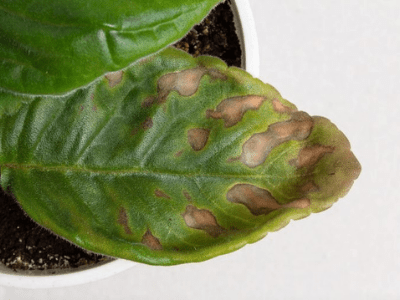
Brown spots on houseplants can be caused by six different things. They include:
- Excess light/scorching
- Low humidity
- Pests
- Leaf spot diseases
- Watering problems
- Fertilizer problems
Taking each condition one by one, let’s explore the cause and find a solution for your plant…
Excess Light/Scorching
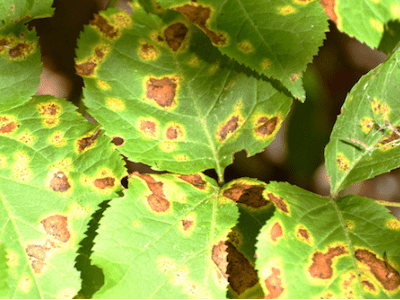
Usually, houseplants grow in the shade of the forest understorey…
This indicates that they may have adjusted well with the shorter levels of light located within your home.
It is important, though, to remember that too much light…
… whether it’s natural or artificial, can cause plants to burn or scorch.
If your houseplants have been burned or scorched you’ll find brown spots on their leaves…
… brown tips, or even pale yellowed leaves.
In severe cases, you could recognize a mixture of these symptoms.
Hence…
To determine whether your plant is suffering from these symptoms…
First, determine the direction of lighting it receives.
Is there direct sunlight emerging along through the window,
…or is this just showing up across an artificial light source?
Leaving the leaves too close to artificial light or direct sunlight…
…may make them burn, resulting in brown leaf tips and brown spots.
If you could move the plant farther from the window you could reduce the intensity of the light.
The plant can also be moved away from direct sunlight…
… so that it only receives bright, indirect light, which suits many houseplants.
Moreover…
The intensity of the light may also change with the seasons which can lead to scorching.
If you had a happy plant in a south-facing window over the winter…
…you may need to move it farther away…
…or to a new location in the summer as the light intensity increases.
In case only a few leaves have been damaged you can prune these off safely.
If the plant is badly affected, you should wait…
…until new growth has begun before pruning the damaged leaves.
When removing scorched leaves, try to mimic the natural shape of the plant’s leaves…
If the tips are damaged, you can trim them off with hygienic, sharp blades.
Regardless of the fact that scorch damage cannot be changed….
…the plant will hopefully grow new, healthy leaves in due course….
…and the old leaves can be excluded to make your plant fresh.
Get your plants inside your house!
Sunlight can become too harsh for your plants at times.
It is not a problem to bring your plant inside the house.
Brown spots on the leaves could also be caused by inconsistency in lighting.
LED Spectrum Lights can be used to provide the best lighting for your indoor plants.
- Full Spectrum - Barrina LED grow lights 4ft provide indoor plants with full-spectrum sunlight replacement. It provides the most reasonable grow light wave based on the ratio of the absorption of the plants
Next…
Low Humidity
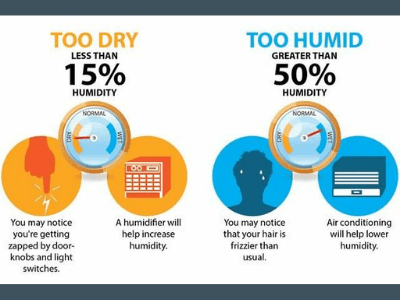
The humidity in your home and especially around the plant may be contributing to crispy brown leaf tips.
If this is the case, you may need to change the humidity level.
If you notice leaf drop and flower buds are falling off…
… and too much or too little light is not the cause, the culprit could be too little humidity.
When humidity levels are too low, plants such as Calathea…
… will quickly develop brown spots or leaf tips.
As winter approaches, it’s common for the rise of humidity inside a home…
… to fall dramatically since cooler air contains less humidity and central heating will also dry out the air.
A digital hygrometer is an excellent investment if you struggle to keep your houseplants healthy.
At a glance…
You can see how humid your home is and adjust the humidity levels accordingly.
Plants need much higher humidity than what is found in the home…
… so you should place the plant on a pebble tray so that it can grow.
Pebbles should be placed in a dish and water should be poured over them…
… so that the water does not quite reach the top of the pebbles.
You should place your plant pot over the pebbles, but not directly in the water…
… because this will contribute to raising the surrounding humidity.
You can group plants close together to increase the humidity around them.
After the plant has recovered, cut out only the brown tips with clean, sharp scissors.
If you notice a leaf that is more than two-thirds brown, it may be necessary to remove it entirely.
The solution to this is that you can always spray water around the plants to increase humidity with a bottle sprayer that could split the water into smaller particles for your plants to absorb.
- Multi-Functional: VIVOSUN 50-ounce handheld pump sprayer designed for spraying plants, car cleaning & maintenance, pet bathing and more indoor or outdoor cleaning solutions; Especially suitable for indoor use; This product is tested to ensure safety at water temperatures up to 131°F
Pests
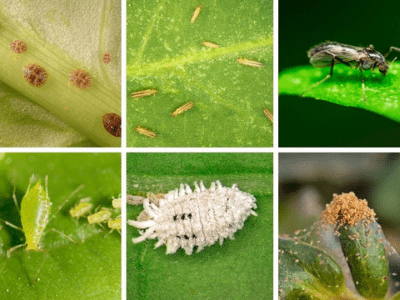
Nothing is more depressing than discovering leaves with small brown spots.
That’s when spider mites have taken over.
Besides mottled leaves, you may also see fine webbing…
… on the underside of the leaves, which also indicates the presence of spider mites.
You can remove the spider mites in various simple ways.
Washing spider mites off with room temperature water…
… is one of the easiest and least expensive ways of control.
Ensure that infected plants are washed once per week…
…making sure to rub off any webbing that’s present.
Maintain a high humidity level around your plants…
… during the time in between washings to prevent the spider mites from spreading.
In addition to room temperature water, you can apply neem oil to the leaves!
Other sap-sucking insects may also cause damage to houseplant leaves.
Mealybugs, aphids, thrips, and scale are common culprits…
All these bugs feed by sucking the sap from the leaves…
… and stems of your houseplants, damaging a small area…
… around where they feed, causing brown or yellow spots on the leaves.
Regularly checking your houseplants for signs of pests is good practice…
If you suspect an infestation, immediately quarantine your plant.
Get the pest away by spraying neem oil on the leaves of your plants
- Insect killer: kills aphids, mealybugs, mites, white flies, and more
Rust
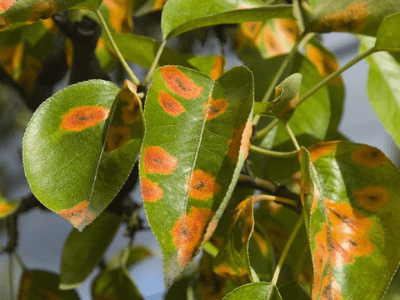
The brown spots on your plant’s leaves are actually collections of spores…
… and the brown rings under the leaves usually refer to rust.
Rust is a fungus that normally occurs in moist environments.
Rust spots are simple to identify because they can be removed with a cloth.
Check to see if the color transfers to the material…
….to see if you have a rust problem.
Rusted plants should be quarantined and treated with a sulfur-based fungicide.
First, remove the rusted leaves, place them in a plastic bag, and discard them.
Bacterial Leaf Spot
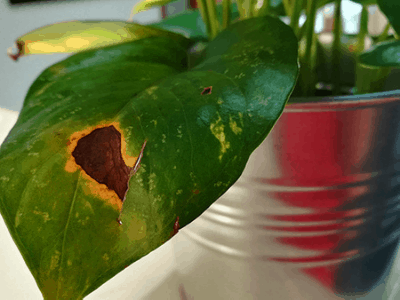
If your plant leaves have sunken, wet-looking brown spots, you may have bacterial leaf spots.
Plants that are kept in overly humid or poorly ventilated environments….
….are more likely to develop bacterial leaf spots.
The presence of bacterial leaf spots on your plants can be a serious problem.
Infections that affect the leaves and stems may be treated with removal…
… but more widespread diseases can be fatal for your plants.
If your plant is infected, you should isolate it to prevent a widespread infection of your other houseplants.
Have you ever heard of this before?
Anthracnose
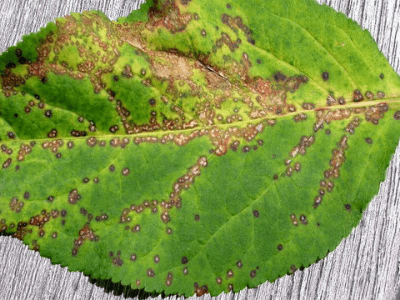
Anthracnose is a fungal disease that causes…
….dark lesions on the leaves and stems of plants.
The leaves are covered in numerous, irregular spots that grow slowly over time.
The irregular appearance of the spots on the leaves makes it easy to identify.
Although they are normally not harmful to houseplants…
… they can spread easily and impair the appearance of your plants.
Plants that are affected should be quarantined, their affected foliage removed…
… and they should be treated with a copper-based fungicide.
Root and Stem Rot
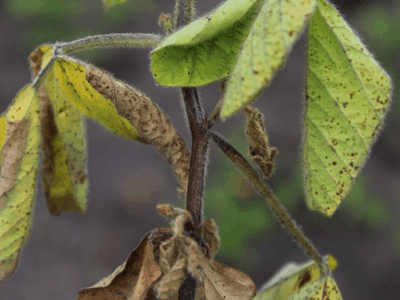
Root rot and stem rot are typically caused by excess watering and poorly draining soil.
You may have a problem if you notice brown and black spots on the roots and stems of your plants.
… in fresh soil with their roots removed.
The affected plants should be replanted…
Make sure your pot has drainage holes and empty the catch tray after you’ve watered it.
Fungal Leaf Spots
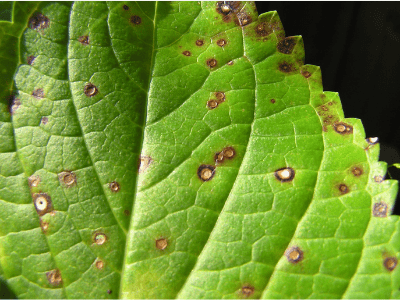
You can treat a plant with neem oil according to the instructions on the bottle…
… the next time you notice a little brown spot on one of the leaves.
Remove the affected leaves and destroy them…
… then apply neem oil as directed on the bottle.
Neem oil may not be able to prevent further infection, which may necessitate the plant’s destruction.
Watering Problems
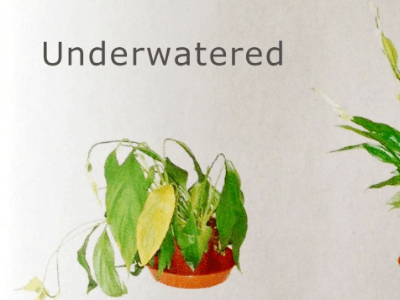
Sometimes when your leaves are browning or dying….
it could mean that the soil is saturated and you are experiencing underwatering.
Check to see if the soil is arid; if it is, this could indicate a waterlogging problem.
Give your plant a good soaking in water.
Do not simply leave it in wet soil; drain the drip tray once the soil has completely drained.
After a few hours, your plant should begin to perk up.
If you want to avoid this problem in the future,
…make sure you understand your plants’ watering requirements.
Some plants require moist but not soggy soil.
Others demand that the soil not become wet between waterings.
The winter months signal the beginning of the dormant period…
… in your indoor houseplants, when they are much less water-dependent.
However, when the spring arrives and the daylight hours increase your plants’ need for water increases.
Watering issues can sometimes be brought on by the change…
…in the season because of the change in water needs.
Simply solve the problem by having a self-watering planter. You can also use a self-aerating planter if you think a solely self-watering planter could harm the roots.
Fertilizer Problems
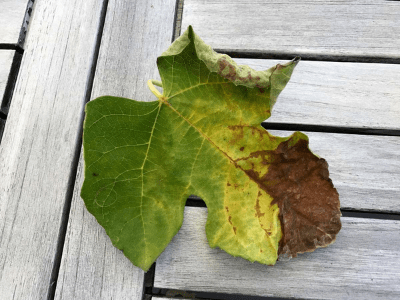
In the event that you can see brown leaf tips on your plants…
… a build-up of too much fertilizer salt may be tripping your plants up.
Initially, you should remove any crusty build-up from the top of the soil.
It is necessary to thoroughly wash the soil to remove any excess salts…
… which is something that you should do at your sink so as not to cause water to spill all over.
Allow the excess water to drain out of the soil…
… and do not water again until it has dried.
Rinse the soil thoroughly with water.
After the soil has been thoroughly rinsed, allow it to dry out.
It may be necessary to completely repot your plant in fresh soil if there is a significant salt build-up.
Your soil may also require a monthly flush if a large salt deposit has accumulated…
Fertilize your houseplants cautiously to prevent problems.
You may have underestimated how much fertilizer your houseplants need.
Know your plants’ fertilizer requirements and use them carefully.
How To Cure Browns Spots on Houseplants?
You might have trouble figuring out precisely why your plant is malfunctioning.
Once you have followed all of the steps and still cannot figure out…
… the reason for brown spots on your plants, is you should take some time…
… to observe the plant and review its care requirements…
… to ensure that the correct conditions are being provided.
While you are trying to identify the problem, I suggest doing the following:
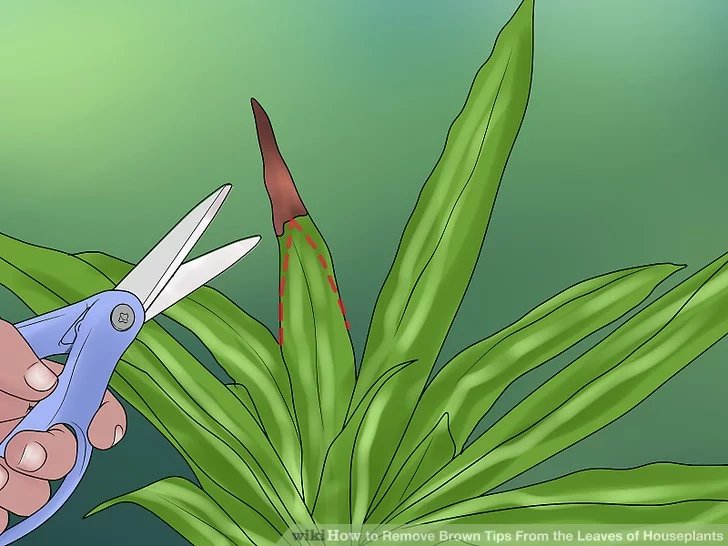
- Use a pruner scissor to cut out leaves or foliage that is damaged.
- Between using plant tools, make sure they are thoroughly clean and sanitized to avoid spreading infection.
- To prevent pests attack on your plants, apply neem oil on the leaves.
- Make sure to water the plant only when the soil is dry, but don’t let the leaves wet.
- You should closely observe your plants to identify any problems,
taking into account the type of care they receive and the environment they are in.
For houseplants with brown spots, prevention is the best medicine.
It is critical to understand and supply what your plant requires in order to avoid brown spots on its leaves.
Maintain the health of your plant by providing it…
….with the proper amount of sunlight, water, humidity, and fertilizer.
To Sum it Up…
It turns out that brown leaves on houseplants aren’t caused primarily by sunburn.
Aside from excessive light, there are nine other causes, including low humidity, pests, and rot.
Not to worry, because this article has solutions to the problem of brown leaves on houseplants.
Conclusion
You may be concerned about brown leaves on houseplants.
So keep this article as your guide…
Or comment down below for further inquiries…
You can also contact us for more information.
Have an awesome gardening journey!
Frequently Asked Questions
What causes brown spots in leaves?
Spotted leaves occur when fungal spores in the air find a warm, wet, plant surface to cling to.
As soon as that microscopic spore gets comfortable in its new home, sporulation (the fungal method of reproduction) occurs and the tiny, brown fungal leaf spot begins to grow.
Should I cut off leaves with brown spots?
Yes. Remove brown and dying leaves from your house plants as soon as possible, but only if they’re more than 50 percent damaged.
Cutting off these leaves allows the remaining healthy foliage to receive more nutrients and improves the plant’s appearance.
Can brown leaves turn green again?
No, the brown leaf tips will not turn back to green but you can trim the brown edges to get the plant back to looking healthy.

